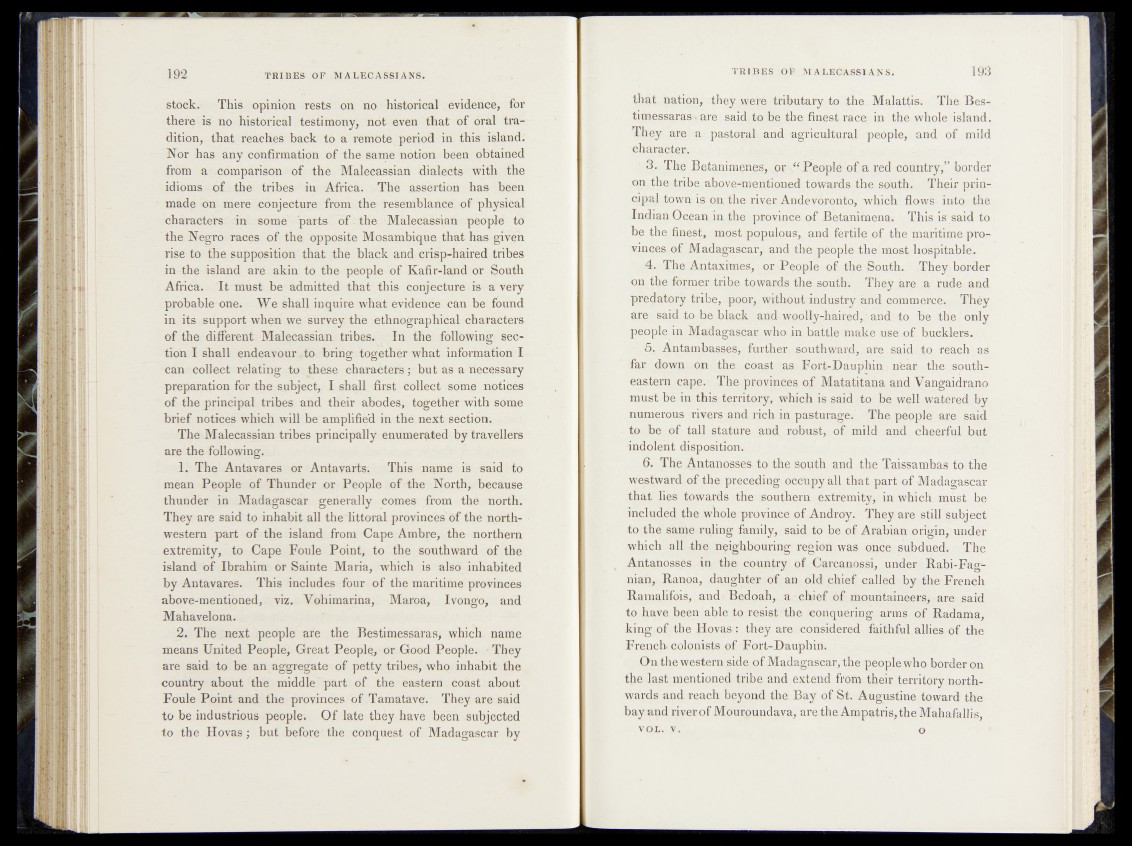
stock.- This opinion rests on no historical evidence, for
there is no historical testimony, not even that of oral tradition,
that reaches back to a remote period in this island.'
Nor has any confirmation of the same notion been obtained
from a- comparison of the Malecassian dialects with the
idioms of the tribes iu Africa. The assertion has been
made on mere conjecture from thé resemblance of physical
characters in some parts o f : the Malecassian people to
the Negro races of the opposite Mosambique that has given
rise to the supposition- that the black and crisp-haired tribes
in the island are akin to the people of Kafir-land or South
Africa— It must be admitted that this conjecture is a very
probable one. We shall inquire what evidence can be found
in its support when we survey the ethnographical characters
of the different Malecassian tribes. In the following Section
I shall endeavour.to bring together what information I
can collect relating to these characters; but as a necessary
preparation for the subject, I shall first Collect some notices
of the jprincipal tribes and their abodes,, together with some
brief notices which will be amplified in the next section. M
The Malecassian tribes principally^ enumerated by travellers
are the following.
1. The Antavares or Antavarts. This name is said to
mean People of Thunder or People : of the North,; because
thunder in Madagascar generally comes from the north.
They are said to inhabit all the littoral provinces öf the northwestern
part of the island from Cape Ambre, the northern
extremity, to Cape. Foule Point, to the southward of the
island of Ibrahim or Sainte Maria, which is also inhabited
by Antavares. This includes four of the maritime provinces
above-mentioned, viz. Vohimarina, Maroa, Ivongo, and
Mahavelona. ..
2. The next people are the Bestimessaras, which name
means United People, Great People, or Good People. They
are said to be an aggregate of petty tribes, who inhabit the
country about the middle part of the eastern coast about
Foule Point and the provinces of Tamatave. They are said
to be industrious -people. Of- late thèy have been subjected
to the Hovas; but before the conquest of Madagascar by
that nation,-they were tributary to the. Malattis. The Bes-
timessaras1*are said.tobe the finest race- in the whole island.
They are a pastoral and agricultural people, and of mild
character.
3. The Betanimenes, People of a red country,”-border
on the tribe above-mentioned;towards the south. , Their prin-
cipal town is on the river Andewdrorito, .which flows into the
Indian Ocean in the province, of Betanimena. This is said to
be the finest,,..rapst populous, and fertile, of the maritime provinces,
of Madagascar,* and the-people the most hospitable.
4. The Antaximes, or People of the South. They border
on the former tribe towards the south. They are a rude and
predatory tribe, poor, without industry and commerce. They
are said to.be black and wpplly-h aired, and to be the only
people in Madagascar who,.in battle make use of bucklers.
Antamla&sses, further southward, are sajdJfo reach as
far down on the coast as Fort-Dauphin,, near the .southeastern
cape. -The provinces of Matatitana and Vangaidrano
must be in this territory, which is said to be well watered by
numerous rivers and rich in pasturage^ ! The. people are said
to be of tall stature and robust, of mild arid., cheerful but
indolent disposition.
' The Antanosses to the south and the Taissambas to the
westward of the preceding occupy all that.part.of Madagascar
that lies towards the southern extremity,, in which, must be
included the whole province of Androy. They are still subject
to the same ruling family, said to be of Arabian origin, under
which all the neighbouring region was once subdued. The
Antanosses in the country of Carcanossi, under Rabi-Fag-
niari, Ranoa, daughter of an old\ehie£ called by the French
Ramalifois, and Bedoah, a chief ipf mountaineers, are said
to have been able to resistHhe conquering arms of: Radama,
king of the Hovas : they are) considered* faithful allies of the
French» colonists of Fort-Dauphin.
On the western side of Madagascar, thepeople who border oft
tjie last mentioned tribe and extend from, theif ,territory northwards
and reach beyond the Bay of Si. Augustine toward the
bay and river of Mouroundava, are the Ampatris, the Mahafallrs
VOL. v. o